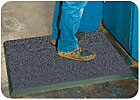
Very often, facilities treat matting systems and the placement of mats as a secondary issue. Matting might be installed only during rain or snow storms or after there is a problem, such as a slip or fall accident, or when there are health complaints from workers who must stand for long periods of time at workstations or on factory lines.
Not giving matting systems the up-front attention they deserve is a mistake, because the proper selection of mats in most facilities, including industrial and warehouse locations, can play a significant role in keeping the operation running efficiently, productively and safely all of the time.
The key word here is proper. Facility managers, working with their distributors, must select the right mats for their facilities. To help ensure installation of an effective matting system — that is specific to your facility’s needs — consider the following issues.
What are your needs?
Slips and falls.Oftentimes, facilities think of mats only when it rains or snows — when concerns mount about worker and customer safety when entering a facility. In these situations, mats are quickly installed at major building entries but might often be removed once the storm has passed. Although keeping moisture outside to prevent slips and falls near entries is a key feature of an effective matting system, it is just one of many benefits mats provide. Safety is also an issue on the plant floor, not just at entry ways. Insurance estimates can place the average cost of a slip-and-fall accident at more than $12,000, with the bulk of these incidents happening within work areas of a facility, not at building entries.
Ergonomics.Studies indicate that standing for long periods of time can cause a number of health-related issues, such as lower extremity discomfort, leg and foot pain, low back pain and overall fatigue, all of which can harm worker productivity. If the problems intensify, as they often do, this can result in absenteeism and costly workers’ compensation claims. Anti-fatigue matting systems can help reduce stress on the body, alleviating many of these physical problems.
Chemical resistance.Certain chemicals such as acetate, lacquer thinner, mineral spirits, alcohol and turpentine may damage some mats. Chemical-resistant matting systems are less likely to be damaged if they come in contact with these and other chemicals.Wet or dry?Finally, ask yourself: How wet or how dry is the area where the mat will be placed? A damp or wet area will usually require a matting system that provides drainage, elevating workers so they never actually step in the moisture. This helps create a safer work environment.
Mats placed in a dry area may also be used for worker safety as well as to help reduce fatigue and contain dust, dirt and soils.
Specialty matting
Be aware of matting systems available for use in very specific areas and conditions in an industrial setting. For instance:
Welding areas.Some industrial locations have welding areas. Mats are often used in these areas to protect floor surfaces, reduce worker fatigue, and capture and trap soils so they are not spread to other areas of the factory floor. In these locations, facilities should install mats that resist sparks and are less likely to be damaged by hot metal shards.
Heavy duty.It is not unusual to find interlocking rubber floor matting systems in gymnasiums and weight rooms. These mats are designed to withstand the dropping of weights or other heavy items on floors. In an industrial setting, they can be effective in places where heavy items are stored or where additional floor protection is required.
Static electricity.Static electricity is another concern in many industrial locations. Anti-static/non-conductive matting systems with high-twist nylon yarns are useful in these applications. Engineered to prevent the buildup of static by removing static charge quickly, they allow for safe use near sensitive electronic equipment not only in industrial settings but also in cleanrooms, computer areas on shop floors and other sensitive areas.
Housekeeping issues
Regardless of which types of mats you select, all mats eventually fill with soil, dust and debris and require cleaning. A soiled mat simply will not perform effectively. On a daily or regular basis, mats should be vacuumed thoroughly. Mats should also be picked up to make sure moisture has not developed underneath them.
Many facilities contract with a matting or textile service that typically picks up the soiled mats on a set schedule determined by the facility’s needs, cleans them offsite, and then reinstalls freshly cleaned mats. This can be a cost-effective way of keeping mats clean and performing properly and reduces the time and labor necessary for the shop custodial crew to clean them.
Throughout every part of an industrial facility, effective matting systems can play a significant role in maintaining safety, health and cleanliness and in improving worker productivity. Instead of considering matting systems only when problems arise, recognize them as important components of any shop design and operation.